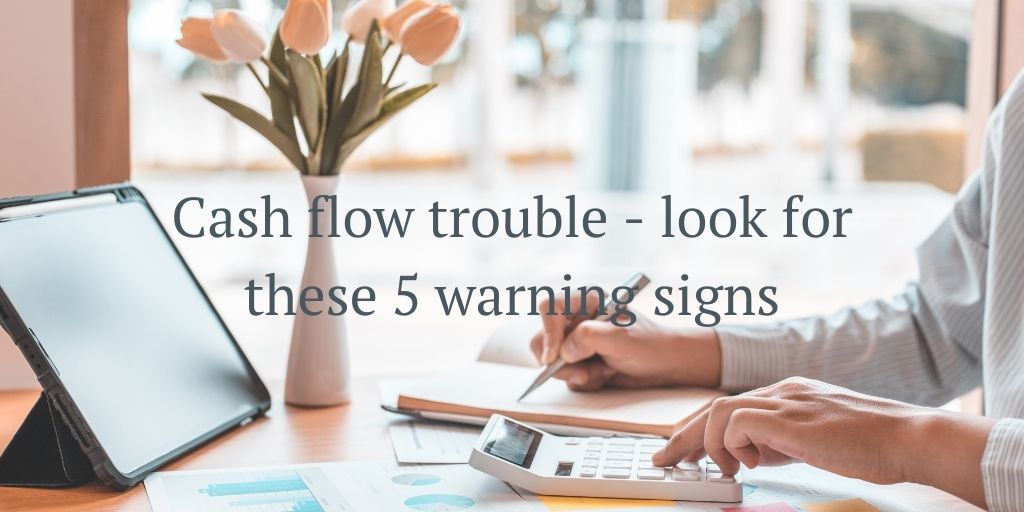
It took me a long time to realise that maintaining a healthy cash flow is critical for any business and I didn’t prioritise cash flow concerns until my business bank balance was dangerously low. This was a big mistake! If we don’t watch out, our business slowly starts bleeding money over time until we get to a point where the flow stops.
Do you wish you had a crystal ball to foresee financial storms heading your way? Well, there are subtle signs that often slip under the radar but could be screaming “cash flow crunch” for your business. Let’s take a look at the signs of impending cash flow challenges and unveil practical solutions to conquer them.
I’m not just highlighting the signs of impending cash flow hiccups here, but arming you with DIY solutions to tackle them head-on. Let’s dive in.
Money disappearing act
Ever felt like your money is pulling a magic trick, disappearing without a trace? Sudden drops in your account balance can be a warning sign. It’s easy to spend when the coffers are full. But control over your business expenses is critical. When you allow expenses to spiral out of control, or use business money for personal or frivolous expenses, you’re making it impossible for your business to survive.
- Create a simple spending diary. Track every business expense and your revenue for a month. Look for patterns, unexpected expenses, or areas where you consistently overspend. This not only sheds light on where your money goes but also empowers you to make informed spending decisions.
- A great way to prevent impulse spending is to have a rule that you must wait a minimum of 24 hours before buying anything over a certain amount, such as $500. When you “sleep on it”, you decide with a clear mind if buying the item is really necessary. Often, you’ll change your mind and realise you didn’t need or want it anyway.
- As entrepreneurs, it’s natural to try out new software, courses and products. However, each month review your expenses to see what’s working for you and what isn’t. You can save money by only keeping the expenses you really need and that benefit your business.
Surprise bills
Bills popping up like unexpected guests? Even if you have a pretty good idea of your regular business expenses, life happens and there will always be peaks and troughs in your business income.
- Set up a dedicated emergency fund. Having a financial cushion can turn unexpected expenses from a crisis into a minor hiccup. Let’s say your average revenue works out to be $60,000 a year after tax – or $5k a month. When you earn more than the $5k, put the excess (after you’ve paid your expenses) in a special buffer account so you won’t spend it. This way, you can weather any rough patches in those months when you earn less than $5k and give yourself time to turn things around. Aim for three to six months’ worth of essential expenses as your safety net.
Income bottlenecks
If the sound of silence is deafening when it comes to incoming payments, it might be time to tune in.
- Make it easy for clients to pay you – Set-up online payments so that people buy your service before you deliver it.
- Sell packages of your time at a discount – For example, if you charge $150 for a one hour session, you can offer a cheaper rate if sessions are pre-purchased in a block of 5 or more. Your clients save money and you get a quick injection of cash.
- Offer payment plans – For your higher priced services, offer monthly (or even weekly) payment plans. This not only ensures a regular flow of cash into your business it works better for your client’s cash flow too. As a bonus it helps you resist the temptation to spend when you receive a large upfront payment in full.
- Implement a follow-up system – If you aren’t collecting upfront payment, make sure you invoice for sales as soon as possible, include payment terms on your invoices, and stick to them. Set automatic reminders for overdue invoices and schedule regular check-ins with clients who are slow to pay to get the money in as fast as possible. Consistent communication ensures timely payments without the awkwardness.
Money juggling act
Tired of juggling personal and business finances and robbing Peter to pay Paul? We’ve all been there. Don’t underestimate the power of putting boundaries around your money! Here’s how:
- Open a separate business bank account (the most important first step) – Have different bank accounts and different credit cards. Only use your business accounts for payments that relate to your business.
- Track your cash flow – Differentiate between exactly what is a business expense and what is personal. Work out the minimum amount you need to make each month to cover your essential business costs.
- Watch your spending habits – For personal spending, treat your business account as you’d treat a former employer’s – hands off. If you have to pay for a personal expense from your business, identify it as “owner drawings” (withdrawals). If you’re putting money into your business, set that up as a loan from you to the business that you will repay. This way you’ll know when your business is actually viable.
- Start the habit of paying yourself – You’re your own boss so make it official and pay yourself each month from your business account. The amount doesn’t matter – you deserve a reward for your efforts. As your income and customer base grows, you can increase the amount. Calculate how much you need to make to meet your living expenses – this is the first owner pay target to aim for.
Debt spiral
Have you been relying too much on credit? Credit cards have many benefits when used properly but unfortunately they can also lead to big financial trouble. The more credit cards you have, the easier it is to get in over your head. And the banks get richer off the late payment and interest fees!
- The key to avoiding credit card debt is to make a habit of charging only what you can afford. Use your credit card to delay paying for things you would buy anyway, and leave your money in your business bank account to pay your balance in full on the due date each month. As long as you’re paying out your credit card balance, you’re staying out of debt.
- Once you can’t afford to pay your full balance, it’s time to stop your credit card spending until you get your balance paid off.
- If you have credit card debt, pay off as much as you can afford every month. If you pay only the minimum each month, it will take years to pay off even the smallest of debts.
These DIY tips aren’t just quick fixes; they’re foundational steps toward financial empowerment.
Finally, remember that mastering your finances is a journey, not a sprint. You’ve got this!
I’m here to empower you with the skills and knowledge to master your money. Check out my social media for inspiration and valuable tips on managing your personal finances and your business cash flow. I’m in your corner cheering you on and I’d love you to join me:
Facebook: https://www.facebook.com/insightspendingplanners
Instagram: https://www.instagram.com/insightspendingplanners

